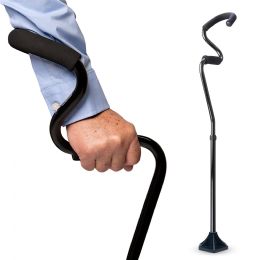


.jpg&newheight=260&quality=80)













What are Straight Canes?
Canes are used to provide support while walking indoors or outdoors. People who are elderly, disabled, recovering from surgery, or rehabilitating from an injury may all require the use of a cane to help them ambulate more securely. Canes are available in a multitude of styles and configurations, including straight canes, quad canes and hemiwalker canes. All canes help to decrease the load on injured or weakened legs, and assist the user with balance while walking or navigating stairs.
Straight canes are the most widely used of the cane styles, and they offer the simplest design. Also known as walking sticks, walking aids, standard canes, C-canes, T-canes and straight-handled canes, straight canes highlight a single shaft with a one-point base, and feature a variety of handles, grips and tips to suit individual needs. The shafts are usually constructed from lightweight but durable materials, such as anodyzed aluminum, wood or plastic, while the handles and grips can be made from a wider variety of materials for comfort and to prevent slippage.
Some straight canes offer the capability to be folded down to put them into a purse or briefcase when they are not in active use. Most styles feature non-slip rubber tips for stability, but some designs include ice-pick tips for safer walking in the snow and ice, or self-standing tips so that the cane will not fall away to the ground if the user loses a grip on it.
How to Choose the Best Straight Cane
Although straight canes may seem pretty straightforward and similar, there are some important aspects to consider when you want to choose the best design for your own individual needs:
Cane Height—choosing the correct working height for the cane is crucial, as if it is too tall or too short, it can cause pain and balance problems for the user. Because it is so important, taking the precise measurements should be done by a friend, family member or caregiver. The intended user should wear normal walking shoes and stand as straight as possible, with arms hanging naturally at the sides of the body. The helper should measure the distance from the ground to the wrist of the user, and it is this distance that should determine the size of the appropriate cane for that user. Many straight canes are adjustable in height in order to be used by a wider variety of people.
Cane Handles and Grips—available in a diversity of styles, the handles and grips of the cane can make a huge difference in the walking experience that the cane provides. Typical hook/crook or C-style canes are not the best choice for those with manual dexterity issues, and may be difficult to grasp for some users. Offset styles are quite popular, as they center the weight of the user, distributing it along the length of the shaft, resulting in much less wrist strain. Ergonomic types utilize the study of the human body and its safest mechanics to reduce pain and stress on the wrists. Many cane handle and grip styles offer fatigue-reducing properties through their unique designs, as well.
While Fritz and Derby styles are similar and were originally designed for cane users with arthritis in the hands, they have become recognized as more medically appropriate cane handles, especially for anyone with manual disabilities or weaknesses. The Derby is thicker than a Fritz handle, and the Fritz generally has a slight hook to it that makes it easier to hang off a chair arm or table. Specially designed contoured handle styles must be ordered for either the right or left hand, as they are so perfectly contoured to fit each hand that they cannot be interchanged. Other cane grips and handles include foam and softer grips, angled handles, pistol/t-grips, palm grip handles and smaller sized grips and handles for smaller hands.
Cane Tips—because the contact the tip makes with the ground should be slip-resistant, most straight cane tips are reinforced with a durable rubber tip. This tip should be inspected often for deterioration, and replaced when necessary to prevent sliding accidents. Ice pick tips are also available for increased security and stability while ambulating through snow and ice during the wintertime. Standing straight cane tips keep the cane upright so that the user can attend to other tasks, and are also helpful for those unable to pick up a cane off of the ground or floor if it falls.
Cane Working Weight and Stability—it is very important to choose a cane that accommodates the user’s weight. The cane cannot provide stability and may break if used by someone too heavy for the weight restrictions determined by the manufacturer.
Additional Cane Features—some other popular features to look for when choosing the best straight cane for your needs are wrist straps that allow for hanging/storing convenience, scratch-resistant finishes for longer-lasting durability and maintenance, and lighted shafts to help users navigate more safely and easily in darker environments.
Hulet Smith, OT
Rehabmart Co-Founder & CEO
ck